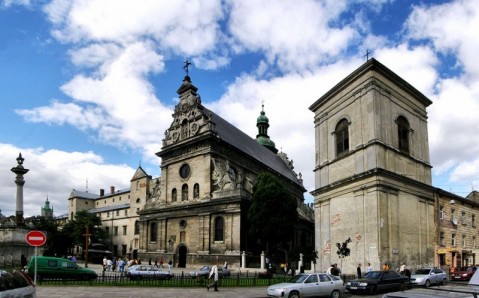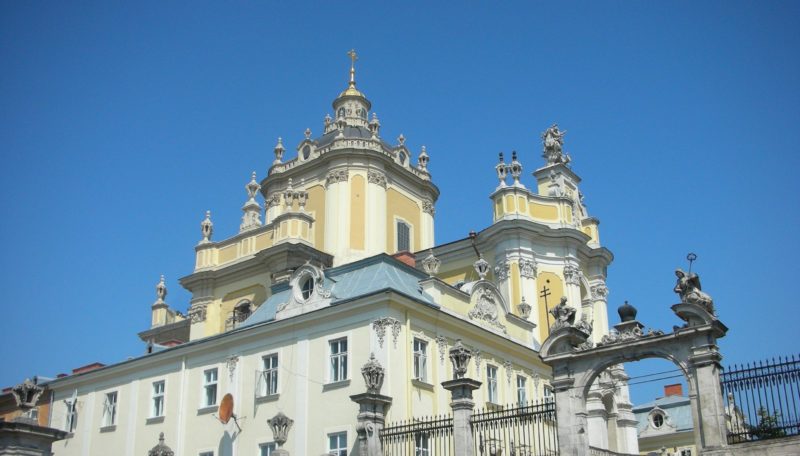By Agha Iqrar Haroon
My journey to breathtaking Lviv instigated me to share another aspect of beauty of Lviv with you which is purely faith and religion centric.
I wrote a series of articles about mystic places including Uch Sharif and Multan (Southern Punjab) way back in 1992 for my newspaper “The Frontier Post under the title of “In Search of Faith”. When I walked around Lviv, I felt there were enough places I could visit as a monk—a person who wishes to find “Religious Aura” of this city.
In this part of Tourism Guide of Lviv, I will share historic and important religious places like churches and cathedrals of Lviv city.
I believe as a student of history that Armenians played an important role in giving unique texture to religious architectural heritage of Lviv. During the 13th and 14th centuries, thousands of Armenians settled in Lviv and most of them were merchants.
Armenians, settled in Ukraine, usually had their own community organizations and their own priests and bishops. Lviv, having been the seat of the Armenian bishopric since 1365, was the center for Armenians’ religious life; therefore, the oldest church of Lviv (Remember Dominican Church was a wooden structure built in 1234) was also constructed by Armenians in 1360.
Armenian Church

According to the available data, a small Armenian church was built in the years 1363–1370. It is said to have been modeled after the Cathedral of Ani in the ancient Armenian capital of Ani.
The present-day interior is largely the work of Jan Henryk Rosen and Józef Mehoffer. The cathedral holds two wonder-working icons of St. Gregory the Illuminator and the Mother of God, brought in the 17th century from Yazlovets. From the 17th century until 1945, the cathedral belonged to the Armenian Catholic archdiocese of Lviv (in Polish, Lwów).
The Dominican Church (Dominican Cathedral)

The Dominican Church (Dominican Cathedral) and monastery is situated in Old Town of Lviv. It was originally built as the Roman Catholic church of Corpus Christi, and today serves as the Greek Catholic church of the Holy Eucharist.
The Dominican Order arrived in Lviv during the 13th century and the first wooden church is said to have been built in 1234 within the Low Castle, founded by the wife of Leo I of Halych but the church was burnt down during a war in 1340. A new Gothic church was built on the present site in 1378 and later rebuilt after a fire in 1407 along with the monastery buildings.
During the 16th century, the complex was damaged by several fires. In the 18th century, the church’s ceiling started cracking and it was decided in 1745 that the church had to be demolished and replaced with a new one. In 1749, cornerstone was laid down for the present day church and the Dominican Monastery. According to the available documents, the church was consecrated in 1764 by the Latin archbishop of Lviv Wacław Hieronim Sierakowski.
The Dominican Church survived through the reign of the Austrian emperor Joseph II, who closed many other monasteries. In 1865, a neo-baroque bell tower was added to the complex and during 1885-1914, the renovation of the facade and interior was carried out.
After World War II, the complex was occupied by the Soviets, who used it as a warehouse. In 1973, Soviets changed the church into a museum of religion and atheism. With the collapse of the Soviet Union, the church was given to the Ukrainian Greek Catholic Church and now serves as a parish church but Monastery still serves as a museum (renamed The Lviv Museum of History of Religion).
Bernardine Monastery and St. Andrew Church

The Bernardine church and monastery is located in Old Town, south of the market square (Rynok Square). The monastery along with the Roman Catholic church of St. Andrew (Now called as Greek Catholic church of St. Andrew) has a unique history and an inimitable link with a man (Saint) who is known as “John of Dukla.

John of Dukla was born in 1414 in a middle class religious family. He spent early part of his youth as a hermit in Carpathians forests. At the age of sixteen, he joined the Order of Friars Minors (Franciscans – also known in the region as Bernadines), first moving to the monastery in Krosno, Poland before attending theological school in Krakow.
In 1440, he moved to Lviv, where he spent ,most of his life. His trilingual abilities (he spoke Polish, Ukrainian and German) served him well in preaching the gospel. In 1484 he died at the Bernadine Monastery which was away from main city of Lviv. Historians say that Monastery was attacked and plundered in 1509 by the Moldovans. In 17th century, Monastery and Church were constructed in the same place in the style of Italian and Dutch mannerism and consecrated in 1630. In 1736, a monument to Saint John of Dukla was built in front of the church.

The interior was refurbished in the Baroque style in the years 1738–1740. After the Second World War, the church was closed by Soviets and fell into disuse until the collapse of the Soviet Union and became operational after Ukraine got independence.
St. George’s Cathedral

St. George’s Cathedral (Sobor sviatoho Yura) was constructed between 1744-1760 on a hill top. Historians believe that today’s Cathedral was built at same place where a wooden church was situated around 1280 but was destroyed by King Casimir III of Poland in 1340.
Construction of the present Cathedral was started in 1746 and finished by 1762. Following the necessity of transferring the seat of the metropolitan of the Church to Lviv in the 1800s, St. George’s Cathedral became the mother church of the Ukrainian Greek Catholic Church (UGCC).
Restoration of the cathedral took place in 1996 to commemorate the 400th anniversary of the Union of Brest.
The church’s exterior is awesome, reflecting both western influences and the traditions of Ukrainian church construction.
The most precious relic of the church is the Wonder-working Icon of the Virgin Mary (17th century). It was brought to Lviv from Terebovlia in 1674 by bishop Joseph Shumlianskyi.
In the Cathedral’s tombs, distinguished figures of the Ukrainian Greek-Catholic Church are buried. Among them are Cardinal Sylvester Sembratovych, Metropolitan Andrei Sheptytsky, Major Metropolitan Josyf Slipyj, Metropolitan Volodymyr Sterniuk, and Cardinal Myroslav Ivan Lubachivsky.
The architectural ensemble of St. George’s Cathedral also includes a belfry, the Baroque Metropolitan Palace and chapter house, as well as a garden, enclosed behind two gates.
Travel for Cause—Lviv Tourism Guide Part I
Travel for Cause: Lviv Tourism Guide Part II—Tustan Fortress—A Wooden structure on Rocks
Travel for Cause: Lviv Tourism Guide Part II—Tustan Fortress—A Wooden structure on Rocks
Travel for Cause: Tourism Guide of Lviv Part III — In Search of Faith — Churches and Cathedrals in Lviv
Travel for Cause: Tourism Guide of Lviv Part IV — In Search of Faith — Churches and Cathedrals in Lviv
